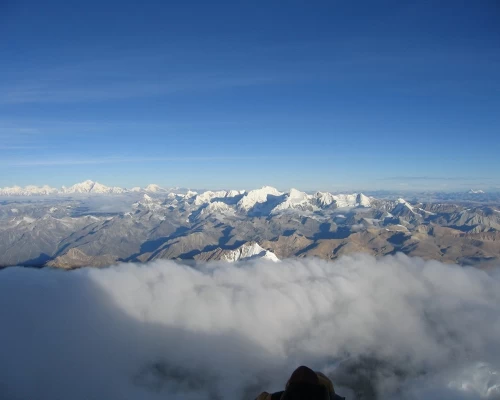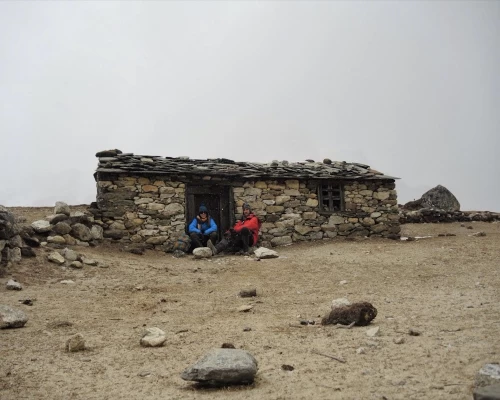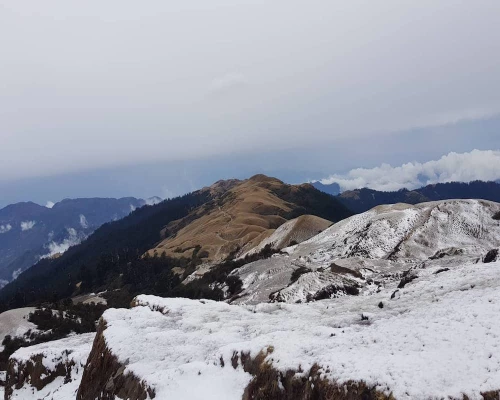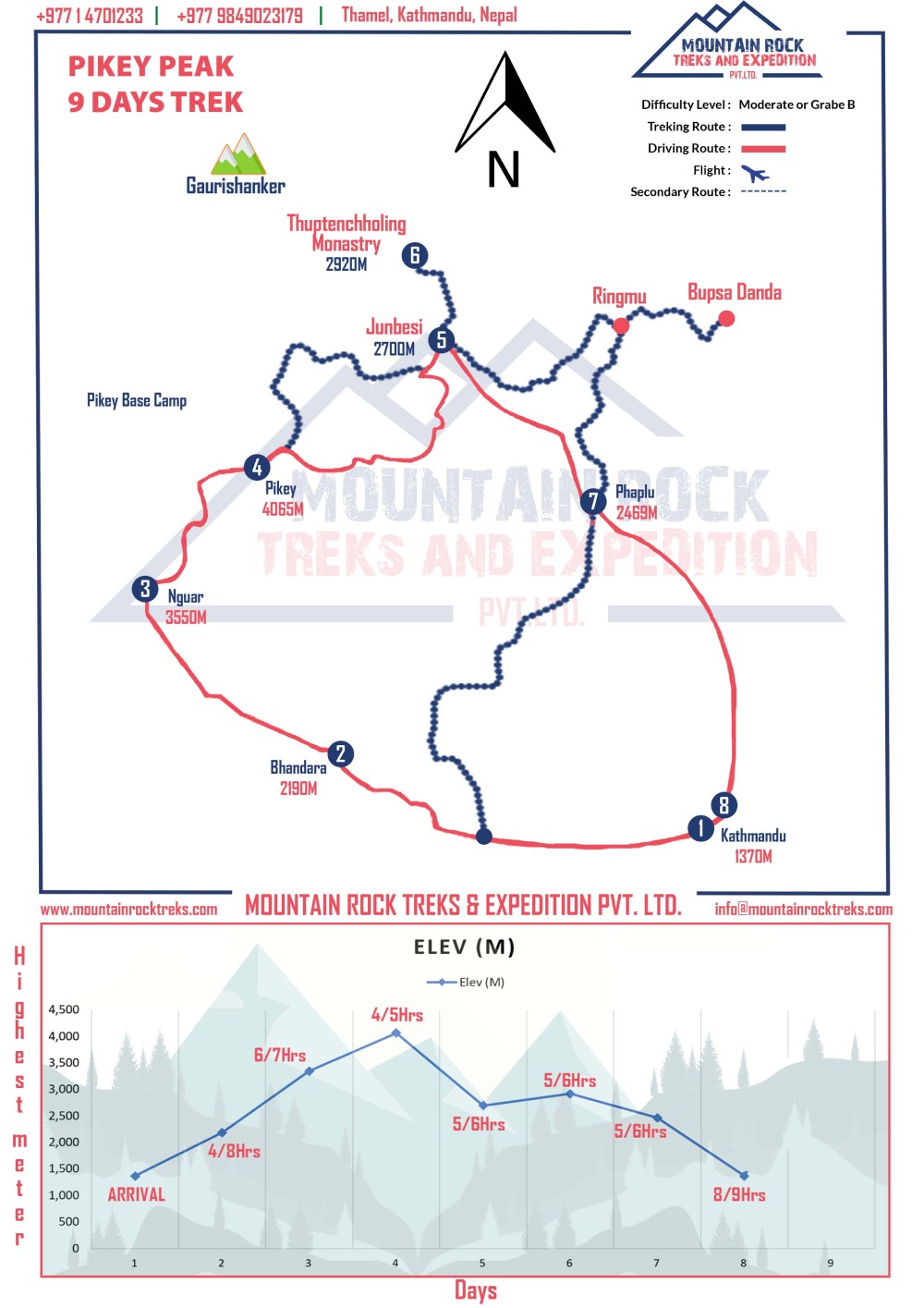Pikey Peak Trek is a fantastic adventure right in the heart of the Himalayas. It's like stepping into a new world with breathtaking views and fascinating encounters with the local culture. We want to share all the incredible things we learned on this journey, so prepare for some valuable insights and useful tips designed for anyone planning this trek.
Pikey Peak is Sir Edmund Hillary’s Favourite Viewpoint
When it comes to viewpoints in Nepal, few can compete with the fame and respect that Kala Patthar in the Everest region and Poon Hill in the Annapurna region have achieved. But there's another spot that's been gaining quite a bit of popularity lately: Pikey Peak. And guess what? Sir Edmund Hillary, the first man who conquered the world's tallest mountain, has said that the view of Everest from Pikey Peak is unbeatable.
Here's an interesting thing about the Pikey Peak Trek: unlike the famous Everest Base Camp Trek, where you only get to see the mountain when you reach the base camp, the Pikey Peak Trek treats you to breathtaking panoramic views of the Himalayas throughout the entire journey. You don't have to wait until the end to glimpse the majestic mountain.
Similarly, while embarking on the trek to Everest Base Camp, the sight of Everest Peak remains elusive until you ascend to Kala Patthar after surpassing Somare. But Pikey Peak is a bit further away from the Sagarmatha massif, giving you crystal-clear views of Everest and other towering peaks reaching a staggering 8,000 meters. Some trekkers even argue that the mountain vistas from Pikey are even more impressive than the ones you get from Kala Patthar near Everest Base Camp.
Nepal boasts an awe-inspiring collection of Himalayan giants towering above 8,000 meters. It's truly remarkable! Everest, Kanchenjunga, Lhotse, Makalu, Cho Oyu, Dhaulagiri I, Manaslu, and Annapurna I, proudly securing their positions among the world's top ten tallest mountains. However, the real gem lies in venturing to Pikey Peak on a clear day, where a magnificent spectacle awaits. The panoramic view unfurls, capturing an uninterrupted vista stretching from one end of the horizon to another. Witnessing this majestic sight, one is consumed by an overwhelming sense of awe, an experience destined to be engraved in memory forever.
The unparalleled sight of the Himalayas from Pikey Peak is an encounter that defies comparison—a truly unforgettable journey.
Why Is Pikey Peak Trek is Right For You?
Less Crowded
Pikey Peak offers a refreshing escape from the crowds due to its status as a relatively new destination. It presents a remarkable opportunity to immerse oneself in the lives of Nepal's diverse ethnic groups, including the Sherpa communities and the Tamang, Chhetri, Gurung, and Rai villages.
Embarking on this journey with us, you are treated to various delectable local cuisines. Moreover, you can witness the enchanting flora and fauna that thrive in this largely untamed region. Recognized as a significant hub of natural and biological diversity, Pikey Peak stands as a testament to its ecological importance.
As you traverse the trail, you encounter a multitude of monuments adorning the landscape, such as stupas and the ubiquitous, vibrant Tibetan prayer flags. These cultural landmarks serve as reminders of the rich heritage and spiritual traditions that permeate the area.
Pikey Peak reveals itself as a dual-summit marvel, with a mere 20-meter difference in height between the two peaks. Yet, from the vantage point of Pikey I, the majesty of the mountains unfolds in an ever-so-slightly superior panorama.
Flexible Itinerary
Most trekking journeys follow a set route, but the Pikey Peak Trek is slightly different. You've got many options when it comes to your itinerary. You can choose other trails and locations based on your time in Nepal and the views you want to soak in.
The popular route for this trek usually starts in Dhap and ends in Phaplu. You've got some flexibility here. You can start from Shivalaya or Jiri and then return to Dhap, or do it the other way around. And if you want to check out Dudh Kunda Lake along the way, you can wrap up your trip in either Ringmo or Phaplu. So many choices for your perfect itinerary!
If you are up for it, you can fly in and out of Phaplu Airport to kick off and wrap up your trek. Phaplu has its airport, so you can hop on a plane instead of enduring a long jeep ride. If you want to fly straight into the region, you can catch a flight from Kathmandu to Phaplu. Tara Air has daily flights from the capital.
Just a heads up, though, booking your flights early is a good idea. Sometimes the weather can be a real problem and cause frequent cancellations. Plus, during the trekking season, many tourists and trekkers visit the country, meaning plane tickets can get scarce. So, better secure your seats ahead of time.
Best Cultural Highlights
One of the remarkable aspects of this trek is the opportunity to witness unique festivals and rituals. If you embark on this journey during March or April, you can experience great festivals. For instance, the Sherpa New Year celebration is brimming with vitality and enthusiasm. In Junbesi, the Dumji festival takes place, where locals unite to partake in traditional dances and rituals.
The Pikey Peak trek typically ranges from 8 to 12 days, contingent upon the chosen route and pace. The optimal periods for this trek are spring (March to May) or autumn (September to November). The weather is usually favorable during these seasons, boasting clear skies and pleasant temperatures.
Considered a concealed treasure, the Pikey Peak trek offers captivating mountain vistas, a chance to immerse oneself in the local culture, and an experience of tranquil natural beauty. It caters perfectly to individuals seeking a more serene trek in the Himalayas, away from the bustling crowds. Nevertheless, it still promises breathtaking views and an opportunity to learn about the Sherpa culture.
Whether you are an experienced trekker or a novice searching for an adventure off the conventional path, the Pikey Peak trek guarantees memories that will endure eternally.
Pikey Peak Trek Challenges:-
The Pikey Peak trek is easy to moderate difficulty, not too hard compared to those popular treks like Everest Base Camp. You'll walk through the lower Everest region without crazy steep or challenging paths. But you'll still be trekking for around 5 to 6 hours daily, which can get tiring for first-time hikers.
The Pikey Peak trek presents moderate difficulty due to its high altitude. When ascending toward Pikey Peak, you will reach an impressive elevation of 4,065 meters (13,335 feet). As you climb further, the air becomes thinner, posing a challenge for your body to acquire sufficient oxygen.
Consequently, the likelihood of experiencing altitude sickness increases. Although Pikey Peak is not as towering as other treks in the region, reaching 4,065 meters is still significant. Trekking at such lofty heights entails difficulties, including decreased oxygen levels and the potential risk of altitude sickness.
However, there is good news: the ascent to Pikey Peak is gradual, allowing enough time to acclimate and minimizing the risk of altitude sickness. Familiarizing yourself with the symptoms of altitude sickness and being well-prepared is crucial. Therefore, take a relaxed approach, maintain a steady pace, and allocate sufficient rest days for acclimatization.
The weather conditions in the Himalayas can be pretty unpredictable, even during the optimal trekking season. While spring and autumn generally offer more stability, it's not uncommon to encounter rain, fog, or snow, particularly in the higher regions.
It is advisable to pack a variety of clothing layers to accommodate the fluctuating weather patterns. Additionally, remember to include warm attire to combat cold temperatures.
If you plan to embark on the Pikey Peak Trek in the Himalayas, be aware, that the weather can be highly variable, especially at higher elevations. Anticipate cold temperatures, occasional rain showers, and even strong winds.
Therefore, pack clothing that can withstand these conditions and ensure comfort. Moreover, mentally prepare yourself for the changing weather, adjust your pace and itinerary accordingly, and you'll enjoy a safe and comfortable trekking experience.
The Pikey Peak trek presents a diverse range of paths, from easy to challenging. Some trails are easily traversable, while others are rugged and uneven, demanding cautious footing. The trek encompasses uphill and downhill sections, including steep inclines.
During the monsoon season, the trails can become muddy and slippery. Use trekking poles to enhance stability and reduce strain on your knees and legs. These poles aid in maintaining balance and provide additional support.
To navigate these terrains effectively, adopt a steady and unhurried approach. Moreover, avoid rushing or ascending too rapidly, heightening the risk of altitude sickness. The Pikey Peak Trek is designed to facilitate gradual altitude gain, allowing your body to acclimate more efficiently.
Make sure to establish a pace that feels comfortable and sustainable for you. Take breaks whenever necessary, and feel free to communicate any concerns or symptoms to your fellow trekkers and guides.
Duration and Daily Walking Distance:
The Pikey Peak trek typically spans 8 to 12 days, contingent upon your itinerary and pace. Each day, you can expect to walk for several hours, covering an average distance of 5 to 15 kilometers (equivalent to 3 to 9 miles). Therefore, preparing your body adequately for this extensive walking endeavor is crucial through regular exercises such as hiking, jogging, or even ascending stairs.
Remote Areas and Limited Facilities:
The Pikey Peak trek encompasses remote regions with limited facilities, such as basic teahouses offering shared amenities and locally available food options. However, certain places may lack conveniences like hot showers or Wi-Fi. Therefore, it is advisable to bring essential items like a sleeping bag, trekking poles, and water purification tablets.
Enhancing your trekking experience involves physical preparation through exercises targeting your heart and legs. Likewise, consult a doctor before the trek, especially if you have pre-existing health conditions.
Despite the challenges the Pikey Peak trek presents, maintaining a positive mindset and savoring the journey at your own pace is crucial. With adequate preparation, gradual acclimatization to the altitude, and cautiousness, conquering the Pikey Peak trek is entirely within reach.
Pikey Peak Trek Best Months For You
You can trek to Pikey Peak anytime, but each season gives you a different vibe, scenery, and adventure. Nepal has four main seasons: Autumn, Spring, Summer, and Winter. Each of them has its upsides and downsides. So, depending on your preferences, you can pick the perfect time for your trek.
Autumn (September, October, November):
Autumn is the best time of the year for Pikey Peak Trek. It's like the post-monsoon season, so you can expect less rain when trekking. But watch out in September. You might get a sprinkle or two.
The weather during autumn is chill for trekking. It's mild and perfect. During the day, it's around 9-15 degrees in the Everest region. It gets a bit cooler as you go higher, especially at night. So, pack some warm stuff. Overall, autumn is far best for Pikey Peak Trek.
Spring (March, April, May):
Spring is the other best time to trek Pikey Peak. It's when nature is showing off its A-game. Spring is like the pre-monsoon season; everything starts blooming and looking stunning. Many rad rhododendron forests surround you on your way to Pikey Peak.
People love trekking in spring because the weather is fantastic. It's around 10-20 degrees during the day, and rain is not a thing. Watch out for a possible drizzle in early May, so pack your rain gear just in case.
Offseason Trek to Pikey Peak:
Trekking to Pikey Peak during winter and monsoon seasons is less famous than autumn and spring. Winter is cold, as the temperature drops below zero in the Everest region, and most lodges and tea houses are closed. Finding a place to crash can be a significant pain, and walking on snowy trails is like a slippery dance party.
Then there's the monsoon, which hits in June, July, and August. It's a rain fiesta in the Everest region. The trails to Pikey Peak become all wet and slippery. Trekking in that muddy mess is no joke. So, only a few people are up for the challenge during winter and monsoon.
Home Stay Accommodation Options at Pikey Peak Trek
Pikey Peak trek is a homestay trek in the Everest region. If you want to soak up the local vibes and lifestyle, staying with a local family is the way to go. It's not just an immersive experience but also gives a much-needed boost to needy families.
Plus, it's cheaper than fancy hotels, so you'll save some serious cash while tasting the local way of life.
When you stay with a host family, they take care of your place to crash and your meals.
You can savor some mouthwatering local dishes, learn the lingo of the area, and even get some insider tips on cool local spots. In a nutshell, your host family will give you an inside look at the local scene you won't find in any hotel.
A homestay trek in Pikey Peak Trek means staying in a village farmhouse or a cozy home of a local villager during your trekking adventure. The family welcomes you as their guest, and you'll share their living space. You might crash in traditional mud or stone cottages, depending on where you go. Some villages hit by the big earthquake in 2015 might have newer concrete homes.
Depending on how long you hang around, you'll be part of the family's everyday life during your stay. If you're staying on a big farm, you can lend a hand with chores. From enjoying the local life of the people here to milking cows to helping out in the kitchen, getting involved in their daily routine will make your travel experience richer and more memorable.
Plus, spending time with your host family will make you more aware of cultural differences and similarities.
In family homestays, you usually get your cozy room with a comfy bed. While newer homes might have bathrooms attached, old-school traditional places might have outdoor toilets. Most homes only have one bathroom, so you might end up sharing it with your host family.
If you're considering staying with a local family while trekking, try to time your trip with a local festival. That way, you can join the celebrations, witness local customs and religious rituals, and have the best experience.
Pikey Peak Weather and Temperature: What to Expect
Pikey Peak in the Everest region can be pretty chilly all year round. It can get as cold as -17 degrees Celsius, especially from December to January. Even during spring, it warms up a bit during the day, but nights are still freezing, dropping below zero. The temperature ranges from a high of 22 degrees in summer to as low as -5 degrees in winter during the day. At night, the temperature can go as low as -15 degrees in winter and around 4 degrees in summer.
Remember to pack your umbrella because it tends to rain there. Rain showers can happen anytime, from drizzles to heavy downpours, especially during summer and monsoon. Speaking of the monsoon season, it's known for being cloudy and misty. This further makes it hard to see the mountains and the surrounding landscapes. So, don't expect excellent visibility, especially at higher elevations.
Starting the trek at lower elevations, like the base, will be a bit warmer. The temperature in the lower region may range from 11°C to 25°C (59°F to 77°F) during the day. But as you go higher, like Pikey Base Camp at 3,640 meters, temperatures can drop to around three °C to 15°C (41°F to 59°F) during the day and even colder at night in the lower area.
Hiking and Trekking Route in Pikey Peak
Your Pikey Peak Trek route starts when you arrive in Kathmandu, the capital city. Then, you hop in a car and head to Bhandara, about 2,190 meters up. The ride is around 7 to 8 hours long, but it is worth it because you get to see some jaw-dropping views along the way.
Once you reach Bhandara, the real adventure begins. You start trekking up to Ngaur at 3,550 meters, which takes about 6 to 7 hours. But guess what? The effort pays off big time because you're treated to mind-blowing vistas of mountains and valleys that will blow your mind.
Keep going, and you'll eventually reach the majestic Pikey Peak, standing tall at 4,065 meters. The hike up there takes roughly 4 to 5 hours, but when you reach the summit, get ready to be mind-blown again. You'll be greeted by a mind-blowing panorama of snow-capped peaks, including the legendary Mount Everest.
After soaking up the views, it's time to head down to Junbesi at around 2,700 meters. It's a 5 to 6-hour trek, and along the way, you'll be treated to enchanting sights of the surrounding landscapes.
In Junbesi, take the chance to visit the Thupten Choling Gompa, a famous monastery sitting at 2,920 meters. It's an excellent spiritual place with incredible Buddhist art and architecture that will blow your mind.
From Junbesi, the trail takes you to the charming village of Phaplu at 2,469 meters. It's about a 5 to 6-hour trek, and you'll pass through lush forests, traditional settlements, and beautiful terraced fields.
Pikey Peak Trek Cost
The expenses for the Pikey Peak trek can fluctuate based on several factors. The overall cost hinges on the duration of your trek, the chosen time of the year, accommodation preferences, and transportation options.
On average, the trek would generally amount to approximately $400 to $500 per individual. Nevertheless, the final price will ultimately rely on the level of luxury you desire and the specific services you seek.
When you make a payment for the Pikey Peak trek, it typically encompasses a multitude of provisions. These provisions usually include transportation to and from the trek's starting and ending points, accommodation in local lodges, guesthouses, or perhaps even homestays, delectable meals to keep you energized, as well as the invaluable assistance of a guide and porter to navigate the trail and manage your belongings.
Some trekking agencies may even include additional perks such as travel insurance, permits, and equipment rental as part of the package.
Remember that the Pikey Peak trek tends to incur higher costs during peak seasons, namely from September to November and March to May.
During these times, a significant influx of adventurers leads to an increase in prices. These months are popular among trekkers due to more favorable weather conditions, making them an ideal time to embark on the journey.










